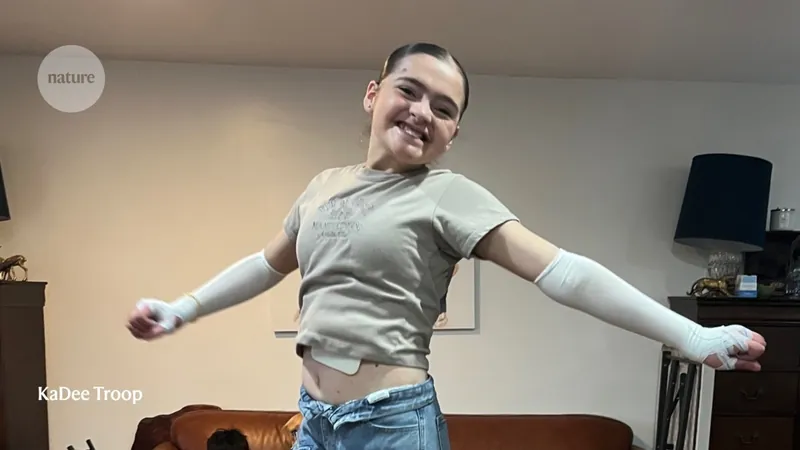
Revolutionary Gene Therapy Transforms Lives of Children with Rare Skin Condition
2025-08-27
Author: Wei Ling
A Mother’s Journey of Hope
KaDee Troop, a mother of seven, has witnessed unimaginable struggles with four of her children who suffer from a rare genetic disorder known as epidermolysis bullosa, or "butterfly skin." This debilitating condition causes their skin to blister and tear with the slightest touch, leaving wounds that are slow to heal, if they heal at all.
For years, their injuries were managed with gauze and bandages, providing little hope for improvement. But in 2023, that changed dramatically when regulators approved a groundbreaking gene therapy.
Breakthrough Gene Therapy
The newly approved treatment, beremagene geperpavec (B-VEC), became the first gene-replacement therapy for a non-cancerous skin disorder and the first topical gene therapy designed for at-home use. The Troop children began applying this innovative gel to their wounds, and the results were nothing short of miraculous.
Wounds that had been persistent and unyielding for years began to close, giving the children newfound confidence and independence. Jayne, now 14, thrills in her gymnastics on the trampoline, while 12-year-old Alex flies over rocky trails on his mountain bike, symbolizing a newfound zest for life. 'Things have changed in a big way,' KaDee exclaims.
A New Era in Genetic Medicine
The success of B-VEC, developed by Krystal Biotech, marks a pivotal moment in genetic medicine—signaling a shift from merely managing symptoms to actually repairing the molecular root cause of diseases. This therapy not only benefits the Troops but opens doors for tackling other inherited skin disorders, including a recently approved therapy for recessive dystrophic epidermolysis bullosa.
While experts like dermatologist Emily Gorell caution that these treatments are not cures, they represent significant progress for conditions that have historically been met with indifference.
Innovative Approaches to Healing
B-VEC utilizes an engineered form of the herpes simplex virus (HSV) to deliver genetic instructions directly to the skin, providing a remarkable alternative to traditional treatments. This method allows the therapy to be safely and repeatedly applied—a game changer for patients with fragile skin.
Clinical trials revealed that two-thirds of wounds treated with B-VEC healed completely within six months, compared to fewer than one-quarter of those treated with a placebo gel.
Commercial Challenges Despite Success
Despite groundbreaking innovations, the journey of gene therapies is fraught with challenges, especially concerning funding and market viability. Many promising therapies have vanished not due to ineffectiveness but due to a lack of commercial support, leaving patients facing unfilled medical needs.
The Future: Expanding Horizons
As researchers make strides with existing therapies, there is a hopeful outlook for further advancements. Other gene therapies, such as prademagene zamikeracel (pz-cel), promise continued improvements in treating similar conditions.
Meanwhile, scientists are exploring gene-editing technologies like CRISPR to develop more precise treatments for a wider array of congenital skin disorders.
A Promise of Healing and Hope
The potential of gene therapy reaches beyond alleviating physical symptoms; it could also prolong lives. For the Troop family, this innovation transforms the concept of hope into reality—healing wounds and restoring childhoods.
As KaDee puts it, 'Everything that we have for the future is going to piggyback off what we’re doing right now. Maybe tomorrow will be the day that something comes along and saves my kids’ lives.' This new era of gene therapy is paving the way for a brighter, healing future.


 Brasil (PT)
Brasil (PT)
 Canada (EN)
Canada (EN)
 Chile (ES)
Chile (ES)
 Česko (CS)
Česko (CS)
 대한민국 (KO)
대한민국 (KO)
 España (ES)
España (ES)
 France (FR)
France (FR)
 Hong Kong (EN)
Hong Kong (EN)
 Italia (IT)
Italia (IT)
 日本 (JA)
日本 (JA)
 Magyarország (HU)
Magyarország (HU)
 Norge (NO)
Norge (NO)
 Polska (PL)
Polska (PL)
 Schweiz (DE)
Schweiz (DE)
 Singapore (EN)
Singapore (EN)
 Sverige (SV)
Sverige (SV)
 Suomi (FI)
Suomi (FI)
 Türkiye (TR)
Türkiye (TR)
 الإمارات العربية المتحدة (AR)
الإمارات العربية المتحدة (AR)